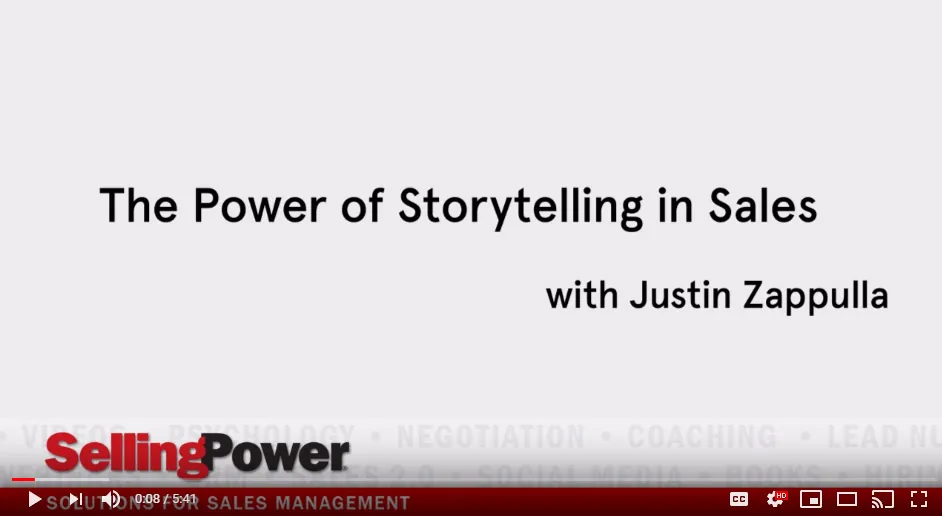Tips for More Effective Sales Storytelling

There is something fundamental about storytelling. Just after the first humans arrived in Europe 30,000 years ago, we find cave drawings in France and Germany. Of course, these were lions and rhinos, but they tell a story of the people and their culture. This need for storytelling carries through all ancient societies like Sumer, Egypt, Greece, Rome.
Similarly, salespeople have employed storytelling for generations. It’s a way to build rapport and showcase experience and expertise. More than anything, it’s a way to connect. In fact, storytelling is about bonding with others. When we tell stories, we don’t just describe events; we share feelings, emotions, lessons. Today, with uncertain markets and unforeseen challenges, sellers must be better storytellers. Here are ways to master your own sales storytelling:
Know Your Audience
Before beginning any story, know your audience. As all sales approaches are not for all clients, some stories are NSFW—not suitable for work. Research is key. Of course, when prospecting, you want to know their company, industry, size, and revenue. However, for storytelling, know the client as a person. Some questions to think about include:
- Where are they from?
- What is their communication style?
- What is their sense of humor?
- What stories have they shared with you?
- What are their needs?
For psychologists, different regions feature different personalities. For example, Midwesterners are characterized as personable and friendly. They tend to be family-oriented, religious. In contrast, Northeasterners are considered temperamental, aloof, irritable. The West Coast, Rocky Mountains, and Southwest feature individualism, tolerance, and libertarian values. Of course, this is not definitive. However, a general idea of your client can determine the extent and limits of your storytelling.
Of course, most sales stories are true, and you can’t cater to all clients. However, when possible, involve the client. Provide historical guides, such as “When the dot-com bubble burst” or “Just after September 11th.” This places your client in the moment of your story, albeit tangentially. And it invites participation, like “I remember that!” Know your client’s family situation. For example, “You know how it is with kids.”
Your client’s communication style can also influence storytelling. No nonsense, direct communicators want the meat of the story. They’re not interested in vegetables or plate arrangement. For these clients, get to the point quickly. Keep it short. Stick to facts. And like a presentation, wrap it quick.
Know your client’s sense of humor. If they appreciate a risqué joke, you can highlight a specific funny detail. However, if they are reserved, allude more than you tell. Of course, you might lose a little humor. But you’re a salesperson, not an insult comic. Always be mindful of the client. The goal of storytelling is to connect and illuminate. Never chance offending the client. Instead, rework your story.
Often, you can judge this from the stories your client has shared with you. As a rule of thumb, know your client, and let their personalities guide you.
In addition, know your client’s situation. If they are experiencing a supply issue in the Plains, your knowledge of the region helps. But you’re not a tourist. More than the best diners, you know the routes, “We rerouted to Lincoln.” Tailor your story to reflect their problem. Of course, it doesn’t have to be exact. But it should relate. Similar stories show experience. However, the lessons learned show insight.
Define Character
Central to all stories is character. In most cases, the seller is their own best character. It’s their experience, their insight, that matters to the client. A story about your colleague will not have the same effect. There’s a distance there, like a surgeon saying, “I saw this on YouTube.” Here are some keys to defining your character:
- Personal detail
- Physical description
- Emotional maturity
- Expectations
A personal detail is the defining characteristic. It’s the trait that carries through the story. For sellers, who were you when the story took place? Maybe you were new to a position at a large firm. Here, convey your character’s “character,” such as “Confident, bordering on cocky, I was 22 years old and knew everything about sales.” Famous last words. This sets the stage for the story and the epiphany, the realization, to come.
Describe your character’s physical appearance. Maybe you had teased, hair metal hair. Perhaps a mullet, bangs, ponytail. Give enough so your client can see the younger you. Maybe you wore a pastel suit out of Miami Vice. It’s okay if the client laughs. We’re not judging you—too much. Chances are your client also has a sketchy sartorial past. And the image helps them relate.
In effective storytelling, the character’s emotional maturity is key. At the time, how well did you know yourself? Many young sellers are bold, brash, and super confident. Often, this borders on arrogance. Perhaps the opposite is true. Maybe, as a young seller, you were shy around more experienced colleagues. Maybe one wore a lot of jewelry and had an intimidating nickname, like “The Shark.” Specific images bring stories to life.
In addition, expectation is part of character. For example, “I was going to close my first big deal.” This can be emphasized or undercut. Some fiction writers never give their characters what they want. Others do. But only after the characters no longer want it. In your story, no matter how real, expectation sets up catharsis, the change to come.
Conflict and Resolution
The best stories feature conflict. This is often an impediment or a problem that needs to be solved. Perhaps, as a young seller, you were overly ambitious. You bit off more than you could chew. Maybe, your biggest deal got lost in transit or arrived too late. Here are some examples of common sales conflicts:
- Shipping mishaps
- You dropped the ball
- Your team dropped the ball
- Last minute decision makers
- Last minute demands
Conflict is key. It’s the reason you’re sharing this story. It’s the challenge you overcame, the lesson you learned. In many ways, everything that came before, like the specific details, leads to the conflict. If your hair, suit, and defining trait created character, what did this character do?
For example, “When the product arrived, it was a mess. There were thousands of mismatched widgets, spilling out of soaking wet boxes.” At this point, the client is invested. They’ve seen the character, and they know their mindset. Now, they see the issue. They want to know what happened.
In effective storytelling, build on the images you’ve created. “The next morning, I was in Wichita, on a dirty warehouse floor. Disheveled, my pastel suit was ruined. For three hours, we matched and sorted widgets.”
In storytelling, past fails are your friend. You’re not a perfect person. It’s okay to make yourself the target of the joke. Far more than what happened, the point is what you did, how you overcame a challenge. We all made and make mistakes. Don’t sugarcoat. Sometimes, the bigger the fall, the better the story. Your story should show what you learned, who you are now, and what you can do.
For young sellers, resist the urge to be a hero. Even if a story shows a great win, your proudest achievement, better to downplay than inflate. Rather than, “I single-handedly saved the company $20,000 dollars,” think, “I really learned the value of a dollar.”
In your resolution, concentrate on moving from innocence to experience. This mimics the client’s journey. It’s the reason they are consulting you. It’s the reason you’re sharing your story.
All sellers have stories. That’s the easy part. The trick is using them effectively. For many, this takes practice. For example, each time you tell a story, refine it. Use you active listening skills to gauge interest and engagement. A fallacy of storytelling is that interest creates engagement. Many think that if the client is interested in your subject, they will invest in your story. This is not true. Whether it’s cats in caves or widgets in Wichita, a good storyteller makes stories interesting, regardless of subject. We hope these tips help you tell better stories to connect with and engage your clients.

- Account Planning (12)
- Awards (44)
- Client Testimonial (37)
- Personal Branding (21)
- Podcast (12)
- Research (78)
- Sales Career Development (90)
- Sales Coaching (166)
- Sales Consulting (141)
- Sales Culture (180)
- Sales Enablement (382)
- Sales Leadership (116)
- Sales Management (267)
- Sales Negotiation (14)
- Sales Prospecting (138)
- Sales Role-Playing (19)
- Sales Training (243)
- Selling Strategies (281)
- Soft Skills (78)
- Talent Management (101)
- Trusted Advisor (29)
- Virtual Selling (57)
- Webinar (13)

























